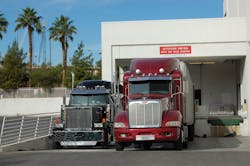Logistics study projects slow economic growth and more “near-shoring” in the future
Sluggish economic growth will continue to be a dominate factor affecting the logistics landscape for the next 12 years, according to a global study conducted by Penn State University, Capgemini Consulting and recruiting firm Korn/Ferry International, with such slow-growth conditions helping spur more “near-shoring” of manufacturing activity back to the North and South America in the future.
The 18th annual study of the global logistics market – also supported by Penske Logistics and the eyefortransport forum – is based on responses from 581 third-party logistics (3PL) firms, 633 users of 3PL services, and 179 shippers that don’t use 3PL providers.
Zack Deming, principal at Korn/Ferry, noted over the next 12 years the biggest challenge facing the global logistic market is slow economic growth, ranging from 1% to 3% for developed economies like the U.S., and Europe, while “emerging markets” in Africa and Asia could see growth range from 2% to 6%.
“In short, the ‘easy growth’ is over; moving forward, such economic uncertainty alongside growing government budget deficits and increased regulatory pressure will make businesses reluctant to invest – especially in supply chain operations,” he said in a conference call with reporters hosted by Wall Street investment firm Stifel Nicolaus & Co.
“That means new types of logistics leaders with different skill sets from the past will be needed,” Deming stressed. “In a relatively flat GDP [gross domestic product] environment, logistics systems will need to be more efficient, more focus will be needed on the customer, more collaborative efforts will be required between 3PLs and shippers, and information technology [IT] will play a far greater role.”
He added that “no playbook with these scenarios” exists in the logistics market today, which is why new “talent” will be needed in the logistics sector. “Agility will be a critical skill; the ability to operate in business environments with a high level of disruption,” Deming pointed out. “There’s already a logistics skills shortage; it will just become more acute for 3PLs and shippers alike.”
As a result, C. John Langley, professor of supply chain information systems and director of development for the Center for supply chain research at Penn State, stressed that 3PLs and other supply chain service providers will need to tap into “Big Data” in order to stay competitive.
“The use of ‘Big Data’ is what’s going to help trucking providers keep their existing capacity loaded and moving,” he explained to Fleet Owner. “Regulatory obstacles, such as the new hours of service (HOS) rules, will impact their ability to do that but if they are able to accumulate and analyze large quantities of data concerning routes, loads, etc., they can continue to improve asset utilization.”
Langley echoed Deming’s point that the right “talent” will be needed to help develop such analytical capability for carriers; not just people who “understand IT,” he stressed, but how to use IT to gain business insights and then foster innovation of transportation services thru those insights.
Shanton Wilcox, logistics and fulfillment leader as well as a principal at Capgemini, noted that one positive development greater economic “uncertainty” where global logistics is concerned revolves around a greater increase of “near-shoring” activity, whereby manufacturing operations in overseas locations such as Asia shift their facilities – and the transport networks that support them – closer to their “final markets,” principally North America and Europe.
“For example, Mexico is now the number two car exporter in the world and that’s because labor rates are equalizing between Asia, Mexico and South America now,” he explained to Fleet Owner. “We’re seeing a lot of manufacturing shifting back to North and South America for that reason and because that shortened their supply chain, lessening the impact of disruptions.”
Wilcox believes that if that labor rate “equality” continues and Africa does not emerge as a low-cost manufacturing hub, the pace of “near-shoring” should increase over the next five to seven years.
“That’s driving big changes in transportation networks,” he emphasized. “In particular, we’ve already seen an overall increase in road traffic between NAFTA [North American Free Trade Agreement] nations due to near-shoring activity.”
Indeed, according to data analyzed by the U.S. Department of Transportation, three out of the five transportation modes – truck, vessel and pipeline – carried more U.S.-NAFTA trade in December 2013 than in December 2012.
According to TransBorder Freight Data compiled by the DOT’s Bureau of Transportation Statistics (BTS), trucks – which carry nearly three-fifths of U.S.-NAFTA trade and is the most heavily utilized mode for moving goods to and from both U.S.-NAFTA partners – rose 7.2% year-to-year while rail declined 2.3%.
Trucks carried 57.2 percent of the $90.1 billion of U.S.-NAFTA trade in December 2013 accounting for $26.3 billion of exports and $25.2 billion of imports. Also, BTS said the surface transportation modes of truck, rail and pipeline carried 79.7% of the total NAFTA freight flows.
That freight trend is also partly an outgrowth of what Capgemini’s Wilcox believes is a greater focus on global trade management or GTM as a “strategy” when it comes to the business of logistics, particularly when it comes to gaining greater visibility of specific items during transport.
“GTM is a more strategic approach for managing margins and profits,” Wilcox noted. “It’s also a response to the explosion in trade over the last several decades: since the 1990s, for example, there’s been a five-fold increase in preferential trade deals between individual nations and groups of nations.”
About the Author
Sean Kilcarr
Editor in Chief
Sean Kilcarr is a former longtime FleetOwner senior editor who wrote for the publication from 2000 to 2018. He served as editor-in-chief from 2017 to 2018.
